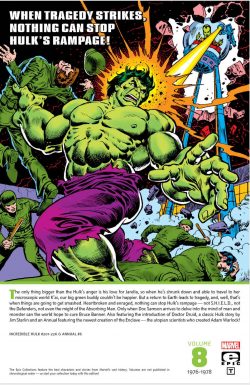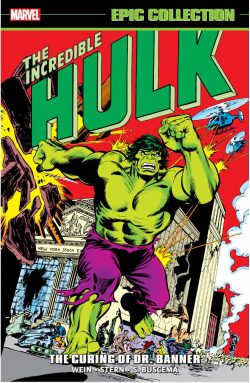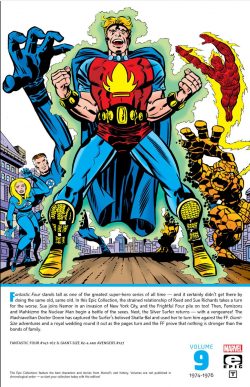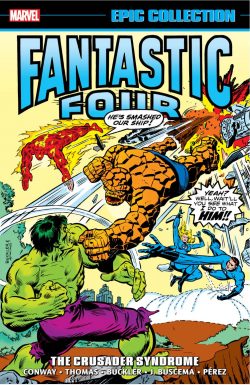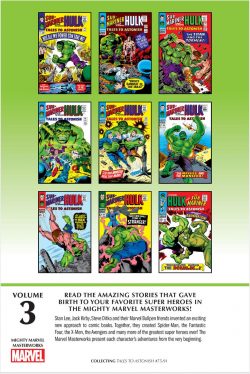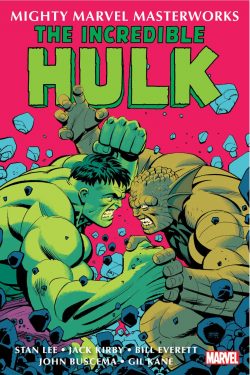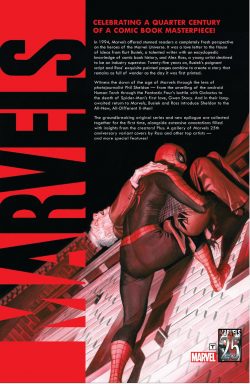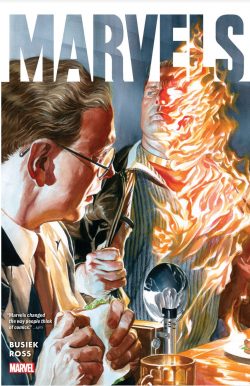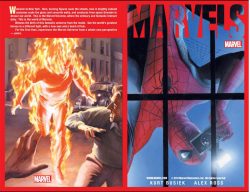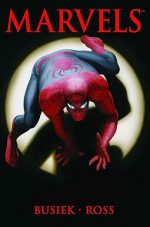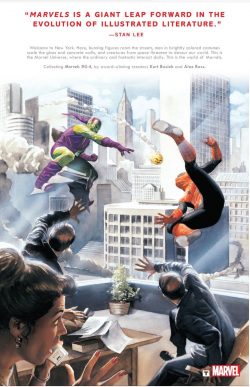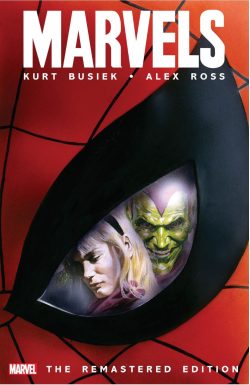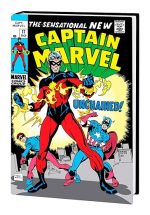
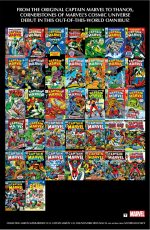
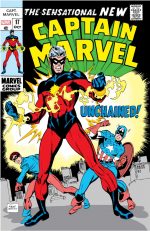
By Stan Lee & Gene Colan, Roy Thomas, Arnold Drake, Gary Friedrich, Archie Goodwin, Gerry Conway, Marv Wolfman, Jim Starlin, Mike Friedrich, Steve Englehart, Don Heck, Dick Ayers, Frank Springer, Tom Sutton, Gil Kane, John Buscema, Wayne Boring & various (MARVEL)
ISBN: 978-1-3029-4865-8 (HB/Digital edition)
Win’s Christmas Gift Recommendation: Behold A New Star… 9/10
After years as an also-ran and up-&-comer, by 1968 Marvel Comics was in the ascendant. Their sales were catching up with industry leaders National/DC Comics and Gold Key, and they had finally secured a distribution deal allowing them to expand their list of titles exponentially. Once the stars of “split-books” Tales of Suspense (Iron Man & Captain America), Tales to Astonish (The Hulk & Sub-Mariner) and Strange Tales (Doctor Strange & Nick Fury, Agent of S.H.I.E.L.D.) all won their own titles, the House of Ideas just kept on creating. One dead-cert idea was a hero named after the company – and one bringing popular cachet and nostalgic pedigree as well.
After the notorious decade-long DC/Fawcett court case that began in 1940, the title Captain Marvel disappeared from newsstands. In 1967, during the superhero boom and “camp” craze generated by the Batman TV show, publisher MLF seemingly secured rights to the name and produced a number of giant-sized comics. Their star was an sapient alien robot who could fly, divide his body into segments and shoot lasers from his eyes. Despite a certain quirky charm, and being devised by comics veteran Carl (Human Torch) Burgos, he failed to attract a following. On its demise, the name was snapped up by expansionist Marvel Comics Group.
Marvel Super-Heroes was new: formerly reprint title Fantasy Masterpieces, it combined monster mystery tales with Golden Age Timely Comics classics, but from the 12th issue it added an all-new experimental lead section for characters without homes – The Inhuman Medusa, Ka-Zar, Black Knight and Doctor Doom -whilst premiering original concepts like Guardians of the Galaxy, Phantom Eagle and – to start the ball rolling – an alien spy sent to Earth from the Kree Galaxy. He held a Captain’s rank and his name was Mar-Vell.
Assembled here, accompanied by three Introductions by Roy Thomas from previous Marvel Masterworks collections and pertinent letters pages are that origin adventure from MS-H#12-13 plus the contents of Captain Marvel #1-33, Invincible Iron Man #55 and a comedy gem from Not Brand Echh #9 collectively spanning cover-dates December 1967 to July 1969…
Crafted by Stan Lee, Gene Colan & Frank Giacoia, the initial 15 page-instalment ‘The Coming of Captain Marvel’ devolved directly from Fantastic Four #64-65 wherein the quartet defeated a super-advanced Sentry robot left behind by a mythical alien race, only to be attacked by a high official of those long-lost extraterrestrials in the very next issue…
After defeating Ronan the Accuser, the FF heard no more from the far from extinct Kree, but the millennia-old empire was certainly interested in Earth. Dispatching a surveillance mission, the Kree wanted to know everything about us. Unfortunately, the agent they chose was a man of conscience; whilst his commanding officer Colonel Yon-Rogg was a ruthless rival for the love of the ship’s medical officer Una. No sooner has the good captain made a tentative planet-fall and clashed with the US army from the local missile base (often hinted as being Cape Kennedy) than the first instalment ends. Stan & Gene had set the ball rolling but it was left to Roy Thomas to establish the basic ground-rules in the next episode.
Colan remained, with Paul Reinman inking as ‘Where Stalks the Sentry!’ sees the alien spy improving his weaponry before an attempt by Yon-Rogg to kill him destroys a light aircraft carrying scientist Walter Lawson to The Cape. Assuming Lawson’s identity, Mar-Vell infiltrates the base but arouses the suspicions of security Chief Carol Danvers. He is horrified to discover the Earthlings are storing the dormant Sentry on base. Sensing opportunity, Yon-Rogg, reactivates the mechanoid. As it goes on a rampage only Mar-Vell stands in its path…
That’s a lot of material for 20 pages but Thomas & Colan were on a roll. With Vince Colletta inking, the third chapter was not in Marvel Super-Heroes but in the premiere issue of the Captain’s own title (May 1968). ‘Out of the Holocaust… A Hero!’ is an all-out action thriller, which still made space to establish twin sub-plots of “Lawson’s” credibility and Mar-Vell’s inner doubts. The faithful Kree soldier is rapidly losing faith in his own race and falling under the spell of the Earthlings. With this issue fans also enjoyed letters page ‘Mail it to Mar-Vell’.
The Captain’s first foray against a super-villain came over the next two issues as we learn that the Kree and the shapeshifting Skrulls are ancient intergalactic rivals, and the latter now want to know why there’s an enemy combatant stationed on Earth. Sending their own top agent in ‘From the Void of Space Comes… the Super Skrull!’, the resultant battle almost levels the entire state before bombastically concluding with the Kree-man triumphant after coming back ‘From the Ashes of Defeat!’
Issue #4 saw the secret invader clashing with fellow antihero Sub-Mariner in ‘The Alien and the Amphibian!’ as Mar-Vell’s superiors make increasingly ruthless demands of their reluctant agent and order him to steal deadly bacteria from a human spaceshot after it crashes off New York Harbor and really ticks off the already fractious Prince of Atlantis.
Captain Marvel #5 saw Arnold Drake & Don Heck assume the creative chores (with John Tartaglione on inks) in cold-war monster-mash clash ‘The Mark of the Metazoid’, wherein a mutated Soviet dissident is forced by his militaristic masters to kidnap Walter Lawson (that’s narrative symmetry, that is). Then #6 finds the Captain ‘In the Path of Solam!’: battling a marauding sun-creature before being forced to prove his loyalty by unleashing a Kree bio-weapon on an Earth community in ‘Die, Town, Die!’ However, all is not as it seems since Quasimodo, the Living Computer is also involved and pulling some unseen strings…
The romantic triangle subplot was wearing pretty thin by this time, as was the increasingly obvious division of Mar-Vell’s loyalties, so a new examination of Dr Lawson, whose identity the Kree man purloined, begins in #8’s ‘And Fear Shall Follow!’. Another alien war story is revealed as Yon-Rogg is injured by rival space imperialists the Aakon. In the battle Mar-Vell’s heroism buys him a break from suspicion but all too soon he’s embroiled with a secret criminal society and the robot assassin apparently built for them by the deceased Lawson. Trouble escalates when the surviving Aakon stumble into the mess in #9’s ‘Between Hammer and Anvil!’…
The war of nerves with Yon-Rogg had intensified to the point that the colonel was openly planning murder and the romantic bond to Una was fractured when Carol Danvers began making her own overtures to the heroic Marvel. Thus, when Ronan orders Mar-Vell to make allies of Lawson’s super-scientific criminal syndicate – at the cost of Carol’s life – the war-hero ignores his orders and pays the penalty. Arrested by his crewmates he faces a firing squad in #10’s ‘Die Traitor!’ and is only saved by an ambush perpetrated by the survivors of the Aakon ship Yon-Rogg had previously targeted in #11’s ‘Rebirth!’
Illustrated by new penciller Dick Ayers, the attack’s aftermath sees the Kree colonel trap his despised rival on a missile hurtling into infinity and assuming his problems are over. During the battle Drake took the opportunity to kill off – as nobly as possible – insipid Medic Una, giving staunch Mar-Vell justifiable reason to openly rebel against his entire race and be reborn under the tutelage of a cosmic entity known only as Zo! who saves the trapped hero from death in the intergalactic void…
Moribund for months, this new beginning with the honourable, dutiful soldier remade as a vengeful vigilante was a real shot in the arm, but it was still clear Captain Marvel the comic was struggling to find an audience. ‘The Moment of… the Man-Slayer!‘ (Drake, Ayers and the great Syd Shores) sees a reconstituted hero gifted with a whole new power set by Zo! and return to Earth.
He is hunting Yon-Rogg but soon distracted by a marauding synthetic assassin at The Cape, in a taut thriller with The Black Widow in deadly guest-star mode. ‘Traitors or Heroes?’ concludes the Man-Slayer storyline with Gary Friedrich, Frank Springer & Vince Colletta as creative team, with the Captain finally confronting Yon-Rogg. The villain escapes by threatening Carol…
In #14’s ‘When a Galaxy Beckons…’ Mar-Vell clashes with a Puppet Master-controlled Iron Man as part of an early experiment in multipart crossovers (Sub-Mariner #14 and Avengers #64 the other parts of a triptych) before leaving Earth… forever, he believes. The going gets all cosmic in #15 (magnificently illustrated by Tom Sutton & Dan Adkins in a boldly experimental manner) as ‘That Zo Might Live… A Galaxy Must Die!’ sees Mar-Vell return to his home world on a mission of total destruction that wraps up the first career of Captain Marvel in spectacular style.
Beguiled and grateful, the hero revisits his homeworld determined to obliterate it for his almighty sponsor only to uncover an incredible conspiracy before the awesome truth is exposed in #16’s ‘Behind the Mask of Zo!’ by Archie Goodwin, Heck & Shores. This yarn is the first great “everything you know is wrong” story in Marvel history and captivatingly makes sense of all the previous issues, supplying a grand resolution and providing a solid context for the total revamp of the character to come. That’s how good a writer Archie Goodwin was. And when you read Thomas’s aforementioned Introduction, a clandestine creative secret is finally revealed…
Captain Marvel #16 is a magical issue and I’m being deliberately vague in case you have yet to read it, but I will tell you the ending. After saving the entire Kree Empire, Mar-Vell is flying back to Earth in his new red-&-blue costume, when he is suddenly sucked into the antimatter hell of the Negative Zone…
It’s probably best to think of everything previously discussed as prelude, since Captain Marvel as we know him really begins with #17 when Thomas, Gil Kane & Dan Adkins totally retooled and upgraded the character. ‘And a Child Shall Lead You!’ sees the imperilled Kree warrior inextricably bonded to voice-of-a-generation/professional side-kick Rick Jones who – just like Billy Batson (the boy who turned into the original Fawcett hero by shouting “Shazam!”) – switched places with a mighty adult hero when danger loomed by striking together a pair of ancient, wrist-worn “Nega-bands”. This allowed them to temporarily trade atoms: one active in our universe whilst the other floated, a ghostly untouchable, ineffectual voyeur to events glimpsed from the ghastly Negative Zone.
As thrilling, and as revolutionary as the idea of a comic written from the viewpoint of a teenager was, the real magic comes from Kane’s phenomenally kinetic artwork and whose mesmeric staging of the perfect human form in motion rewrote the book on superhero illustration with this series.
With pinch-hitting pencilling from John Buscema for the last nine pages, CM #18 at last categorically ended the Yon-Rogg saga and started Carol Danvers on her own superhero career as the Mar-Vell swore ‘Vengeance is Mine!’ The next issue embraced the “Relevancy Era” (where realism and themes of social injustice replaced aliens and supervillains as comics fodder) with a crazed sociologist and too-benevolent landlord revealed as ‘The Mad Master of the Murder Maze!’.
And that’s when the series was cancelled.
As happened so often during that tempestuous period, cutting edge, landmark, classic comic-books just didn’t sell. Silver Surfer, Green Lantern/Green Arrow and many other series modern readers consider high points of the form were axed because they couldn’t find enough of the right audience, but Captain Mar-Vell refused to die. Six months later, CM #20 was released, and the quality was still improving with every page. ‘The Hunter and the Holocaust’ has Rick attempt to free his trapped body-and-soulmate by consulting old mentor Bruce Banner. En route out west, a tornado destroys a town and Mar-Vell first renders assistance and then fights off resource-looters The Rat Pack. With the next issue Cap and Rick’s mentor finally meet, in ‘Here Comes the Hulk!’ but that’s just a garnish on this tale of student unrest and manipulative intolerance. The book was cancelled again after that… only to return some more!
Captain Marvel returned again in the summer of 1972 for another shot at stardom and intellectual property rights security. It all begins rather inauspiciously with Captain Marvel #22 wherein scripter Gerry Conway and artists Wayne Boring & Frank Giacoia reintroduce the cosmic crusader. ‘To Live Again!’ sees Mar-Vell still bonded to Rick by the uncanny Nega-bands, having languished in the Negative Zone for a seeming eternity. Jones had been trying to carve out a rock star career and relationship with new love Lou-Ann, but eventually his own body betrays him and the Kree Captain is expelled back into our reality…
Luckily, Lou-Ann’s uncle Benjamin Savannah is a radical scientist on hand to help Rick’s transition, but as the returned Marvel unsteadily flies off, across town another boffin is rapidly mutating from atomic radiation victim to nuclear threat and #23 (by Marv Wolfman, Boring & Frank McLaughlin) sees the Kree Warrior calamitously clash with rampaging maniac Megaton, resulting in ‘Death at the End of the World!’.
Wolfman, Boring & Ernie Chan then deal ‘Death in High Places!’ as Jones is targeted by murderous Madame Synn and felonious cyborg Dr. Mynde. They need Mar-Vell to help them plunder the Pentagon…
After seemingly running in place, perpetually one step ahead of cancellation (folding many times, but always quickly resurrected – presumably to secure that all important trademark), the Captain was handed to a newcomer Jim Starlin who was left alone to get on with it…
With many of his friends and fellow neophytes he began laying seeds (particularly in Iron Man and Daredevil) for a saga that would in many ways become as well regarded as Jack Kirby’s epochal Fourth World Trilogy which it emulated. However, the “Thanos War”, despite superficial similarities, soon developed into a uniquely modern experience… and what it lacked in grandeur it made up for with sheer energy and enthusiasm.
The first foray came in Iron Man #55 (February 1973) with Mike Friedrich scripting Starlin’s opening gambit in a cosmic epic that changed Marvel itself. ‘Beware The… Blood Brothers!’ (inked by Mike Esposito) introduces haunted humanoid powerhouse Drax the Destroyer, trapped by alien invader Thanos under the Nevada desert and in dire need of rescue. That comes when the Golden Avenger storms in, answering a enigmatic SOS…
A month later in Captain Marvel #25, Friedrich, Starlin, & Chic Stone unleashed ‘A Taste of Madness!’ and the alien outcast’s fortunes changed forever. When Mar-Vell is ambushed by a pack of extraterrestrials, he must finally concede that his powers are in decline. Unaware an unseen foe is counting on that, Rick manifests and checks in with Dr. Savannah, only to find himself accused by his beloved Lou-Ann of the scientist’s murder. Hauled off to jail, he rings in Mar-Vell who is confronted by a veritable legion of old foes before deducing who in fact his true enemies are…
CM #26 sees Rick freed from custody and confronting Lou-Ann over her ‘Betrayal!’ (Starlin, Friedrich & Dave Cockrum), before he and Mar-Vell realise they are targets of psychological warfare. In fact she is being mind-controlled whilst Super Skrull and his hidden “Masterlord” are manipulating them and others in search of a lost secret. When a subsidiary scheme to have Mar-Vell kill The Thing is foiled the true manipulator appears banishing Mar-Vell and capturing Rick because his subconscious conceals the location of an ultimate weapon.
Rick awakes to find himself ‘Trapped on Titan!’ (Pablo Marcos inks) not realising the villain has already extracted the location of a reality-altering Cosmic Cube from him. Rescued by Thanos’ father Mentor and brother Eros, the horrified boy sees first-hand genocide the death-loving monster has inflicted upon his own birthworld and summons Captain Marvel to wreak vengeance…
Following a comprehensive cutaway ‘Map of Titan’ from #27, a return to Earth sees still-enslaved Lou-Ann warning the Mighty Avengers before summarily collapsing. By the time Mar-Vell arrives she lies near death. Inked by Dan Green, ‘When Titans Collide!’ reveals another plank of Thanos’ plan. As the heroes fall to psychic parasite The Controller, Mar-Vell is assaulted by bizarre visions of an incredible ancient being. Fatally distracted, he becomes the massive mind-leech’s final victim…
Al Milgrom inks ‘Metamorphosis!’ as the Kree captain’s connection to Rick is severed as he is transported to an otherworldly locale where 8-billion year old Eon reveals the origins of life whilst overseeing the abductee’s forced evolution into the ultimate warrior: a universal champion gifted with the subtly irresistible power of Cosmic Awareness…
Returned to Earth and reconnected to his frantic atomic counterpart, the newly-appointed “Protector of the Universe” goes after The Controller, thrashing the monumentally powerful parasite in a devastating display of skill countering super-strength in #30’s ‘…To Be Free from Control!’
Much of this saga occurs in other titles and for the full picture you will need to hunt down more comprehensive compilations but here and now, the story continues in Captain Marvel #31 with ‘The Beginning of the End!’ (inked by Green & Milgrom) wherein the Avengers – in a gathering of last resort – are joined by psionic priestess Moondragon and Drax – one of the Mad Titan’s many victims resurrected by supernal forces to destroy Thanos…
The Titan is revealed as a lover of the personification of Death and he wants to give her Earth as a betrothal present. To that end, he uses the Cosmic Cube to turn himself into ‘Thanos the Insane God!’ (Green) and with a thought captures all opposition to his reign. However, his insane arrogance leaves the cosmically aware Mar-Vell with a chance to undo every change; brilliantly outmanoeuvring and defeating ‘The God Himself!’ (inked by Klaus Janson)…
Wrapping up the comics in this first volume is a burst of light relief from Marvel’s sixties parody comic Not Brand Echh – specifically # 9’s ‘Captain Marvin: Where Stomps The Scent-ry! or Out of the Holocaust… Hoo-Boy!!’ as Thomas, Colan & Frank Giacoia wickedly reimagining the origin. It’s either funny or painful depending on your attitude…
With covers by Colan, Colletta, Heck, Tartaglione, John Romita, Marie Severin, John Verpoorten, Barry Windsor Smith, Herb Trimpe, Springer, Shores, Kane & Adkins, Frank Giacoia, Joe Sinnott, Starlin, Marcos, Milgrom & Janson, the bonus section begins with the December 1967 Marvel Bullpen Bulletins page advertising a new hero and includes a wealth of pencilled pages and sketches from Colan and Kane plus many of their original art pages. Also on show is a tee-shirt design and unused Severin cover, covers, endpieces and Milgrom Captain Marv-Al intros from 1980s reprint series The Life of Captain Marvel, redesigned pages used to bridge issues in that series and Milgrom’s lengthy text introduction. Wrapping up is a selection of previous collection covers by Colan, Starlin & Richard Isanove.
Mar-Vell (and Carol Danvers) have both been Captain Marvel and starred in some of our art form’s most momentous and entertaining adventures. Today’s multimedia madness all started with these iconic and evergreen Marvel tales, and it’s never too late for you to join the ranks of the cosmic cognoscenti…
© 2023 MARVEL.














